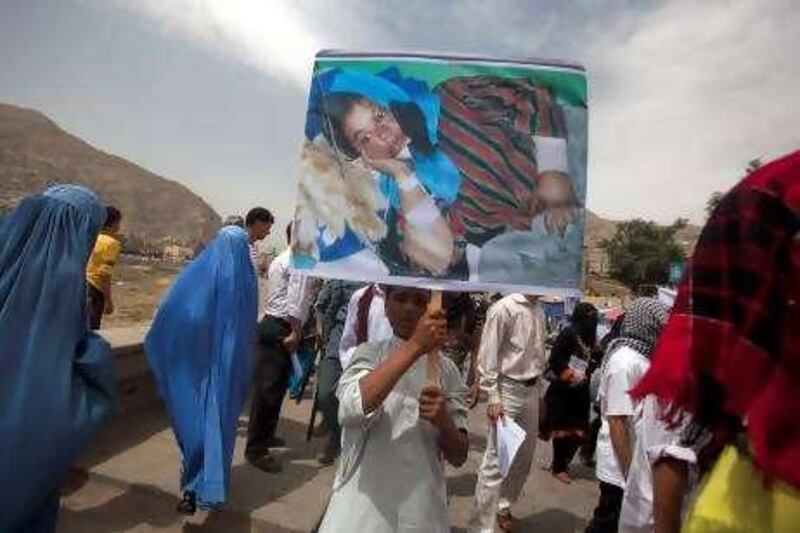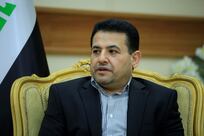KABUL // When US forces responded to an attack on Afghan police in the south-west of the country last year, there was scant evidence in the military's after-action report to suggest the level of carnage that had taken place. A Taliban commander was believed to have been killed and "sources indicate that there will be a substantial INS [insurgent] body count tomorrow", adds the report, one of some 92,000 secret military documents leaked to WikiLeaks and disclosed by the website last week.
Further on, the report briefly mentions that a 1,000-pound bomb had wounded a family, leaving a "little boy" seriously injured. A handful of other people were treated in a local hospital, it notes. This seemingly minor episode in Farah province on May 4, 2009, is now regarded as one of the most horrific incidents of the entire war. The Afghan government put the number of civilians killed at 140, while the Afghanistan Independent Human Rights Commission (AIHRC) found that 65 children and 21 women were among the dead. The US military later acknowledged that at least 20 to 30 civilians might have been killed.
These discrepencies continue to puzzle Mohammed Farid Hamidi, a commissioner for the AIHRC. "It's very difficult for me to understand and know the reason why," he said. "Why is there this difference?" The disclosure of the classified US military documents by WikiLeaks has opened up old wounds among many Afghans who have long felt that international forces show little respect for civilian lives. For some Afghans, reports such as the one about the Farah attack demonstrate a clear lack of awareness of the reality on the ground. For others, they are reminders that war crimes may well have been committed and then brushed aside once the din of battle faded.
"Civilian casualties have caused many criticisms among the people of Afghanistan and caused many questions," Mr Hamidi said. In the tranche of documents provided to WikiLeaks, which cover a period from January 2004 to December 2009, there are dozens of reports that give an insight into the price Afghan civilians have paid and how the US military responds when it has fired the fatal shot or called in the decisive air strike.
Whether they are evidence of bad luck, incompetence or criminality, however, is a matter that is still being debated here and few are confident it will be resolved anytime soon, if at all. Ajmal Samadi, the director of Afghanistan Rights Monitor, has no doubts that what happened in Farah constitutes the deliberate targeting of civilians, or wanton disregard for their lives. In other words, it was a war crime.
"Whoever has issued that command, that person needs to be held responsible. I am sure soldiers have to obey the orders, but those who were well informed that there are risks of civilian casualties - collateral damage to a very large extent - and they overlooked that information and nevertheless ordered the village to be bombed, they are responsible," he said. Some of the incidents covered in the papers were documented at the time, but with telling details missing. In March 2007, for instance, US Marines opened fire in the aftermath of a suicide attack, killing 19 innocent people and wounding scores, yet none of this is mentioned in the initial military report revealed by WikiLeaks.
Other accounts, such as the shooting and wounding of a deaf mute by CIA paramilitaries, appear to have been kept quiet until now. Lal Gul, the chairman of the Afghanistan Human Rights Organisation, said there were "a hundred examples" of foreign forces falsely reporting civilian casualties as insurgents. He claimed it occurred so often it must be deliberate, rather than a mistake. "They say we killed terrorists, Taliban and al Qa'eda even when the media shows the dead bodies of children, old people and women," he said.
Listing a number of incidents in which civilians have been killed, including a notorious air strike in Herat province that left some 90 villagers dead, he insisted war crimes had been committed and those responsible should be punished. Mr Gul warned that the US and its allies would now struggle to win over the public as a result of their history in dealing with these tragedies. "Even if they do kill terrorists or Taliban fighters people will think they are civilians because they reported it wrong in the past," he said.
Afghans are not the only ones to have expressed concern. In New York, Human Rights Watch has issued a statement calling on US and Nato forces to "immediately agree to investigate any previously undisclosed" cases of civilian casualties. Also, Amnesty International said the reports showed that Nato's leadership was often unaware of what was happening. It added that monitoring had improved following the introduction of new rules of engagement last summer.
The Campaign for Innocent Victims in Conflict (Civic), based in Washington, concurred that the militaries involved needed to do "proper investigations" but cautioned against any snap judgements by outside observers. "These documents are important for showing the public what war is like on the ground: real cases of civilian casualties and the devastating aftermath of operations for Afghans," said Sarah Holewinski, the group's executive director.
"That's a view the daily headlines can't capture. But whether these documents are actually revelations that require a public rethink has yet to be seen." csands@thenational.ae





